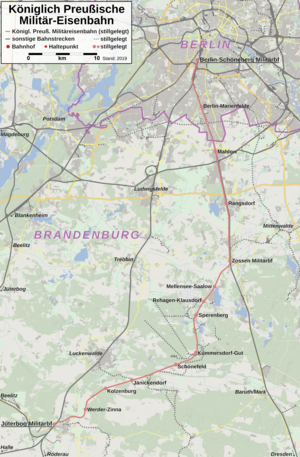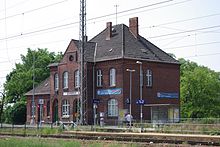Royal Prussian Military Railway
| Royal Prussian Military Railway (1875-1918 / 19) |
|||||||||||||||||||||||||||||||||||||||||||||||||||||||||||||||||||||||||||||||||||||||||||||||||||||||||||||||||
|---|---|---|---|---|---|---|---|---|---|---|---|---|---|---|---|---|---|---|---|---|---|---|---|---|---|---|---|---|---|---|---|---|---|---|---|---|---|---|---|---|---|---|---|---|---|---|---|---|---|---|---|---|---|---|---|---|---|---|---|---|---|---|---|---|---|---|---|---|---|---|---|---|---|---|---|---|---|---|---|---|---|---|---|---|---|---|---|---|---|---|---|---|---|---|---|---|---|---|---|---|---|---|---|---|---|---|---|---|---|---|---|---|---|
|
Berlin military station in Schöneberg, 1902
| |||||||||||||||||||||||||||||||||||||||||||||||||||||||||||||||||||||||||||||||||||||||||||||||||||||||||||||||||
|
Route
| |||||||||||||||||||||||||||||||||||||||||||||||||||||||||||||||||||||||||||||||||||||||||||||||||||||||||||||||||
| Route number (DB) : | 6514 (Zossen – Jüterbog) | ||||||||||||||||||||||||||||||||||||||||||||||||||||||||||||||||||||||||||||||||||||||||||||||||||||||||||||||||
| Course book section (DB) : | last 206.31 (Zossen – Jüterbog) | ||||||||||||||||||||||||||||||||||||||||||||||||||||||||||||||||||||||||||||||||||||||||||||||||||||||||||||||||
| Route length: | 70.5 km | ||||||||||||||||||||||||||||||||||||||||||||||||||||||||||||||||||||||||||||||||||||||||||||||||||||||||||||||||
| Gauge : | 1435 mm ( standard gauge ) | ||||||||||||||||||||||||||||||||||||||||||||||||||||||||||||||||||||||||||||||||||||||||||||||||||||||||||||||||
| Track condition | |||||||||||||||||||||||||||||||||||||||||||||||||||||||||||||||||||||||||||||||||||||||||||||||||||||||||||||||||
| up to km 30.5 | ~ Canceled in 1919 | ||||||||||||||||||||||||||||||||||||||||||||||||||||||||||||||||||||||||||||||||||||||||||||||||||||||||||||||||
| km 30.5-40.0 | Shut down in 1998 | ||||||||||||||||||||||||||||||||||||||||||||||||||||||||||||||||||||||||||||||||||||||||||||||||||||||||||||||||
| km 40.0-70.5 | Closed in 1996 | ||||||||||||||||||||||||||||||||||||||||||||||||||||||||||||||||||||||||||||||||||||||||||||||||||||||||||||||||
|
|||||||||||||||||||||||||||||||||||||||||||||||||||||||||||||||||||||||||||||||||||||||||||||||||||||||||||||||||
The Royal Prussian Military Railway , also known as the Royal Military Railway (KME), was a state-owned railway line operated by the Prussian army between Schöneberg (now Berlin ) and Kummersdorf , which was later extended to Jüterbog . As far as Zossen , the line ran parallel to the Dresden Railway , from there as a diagonal to Jüterbog on the Anhalter Bahn .
The line was opened in 1874 and closed in 1996/98.
history
Construction of the line
After the end of the Franco-Prussian War , the railway troops were to be provided with a training area with this route, as the strategic importance of the railway had increased considerably in the previous wars . On April 22, 1872, the War Ministry decided to build and operate a standard-gauge , single-track military railway and for this purpose provided 750,000 thalers from the French reparations payments . For this purpose, a contract, a so-called punctuation , was concluded on January 9, 1873 with the Berlin-Dresden Railway Company . For the construction of the Dresden train station, the company was given military-fiscal land between the Anhalter freight stations and the Potsdamer Bahn to purchase. To do this, she took over the acquisition and manufacture of the subgrade , the construction of the railway structure and bridges and the procurement of the superstructure and operating material for the military railway . The railway battalion was responsible for laying the superstructure and pouring the bedding .
The preparatory work for the route from Zossen via Sperenberg to the artillery firing range near Kummersdorf began on February 18, 1873. On the route - modified by the suggestion of the Dulon Government Building Council - income was expected from the goods traffic of the adjoining gypsum factories and brickworks as well as timber transports from Kummersdorf State forest.
The main route for exclusively military use was built immediately west of the Berlin – Dresden railway line . Construction began on February 26, 1874, and in August 1874, the laying of the tracks began in Berlin and Zossen. The two construction teams of the battalion met on April 20, 1875, the track construction for the firing range was completed in July of that year. The opening of operations on the 45.62 kilometer long route from the military station Schöneberg to Kummersdorf took place on October 15, 1875.
The line ran to Zossen for a length of about 30 kilometers parallel to the line of the Berlin-Dresden railway and then turned in a south-westerly direction. On May 1, 1897, it was extended by another 25 kilometers to the Jüterbog military station. The railway, owned by the military treasury, was administered by the Royal Direction of the Military Railway .
Also in 1897 a third rail was installed in the track at Rehagen - Klausdorf for a parallel narrow-gauge test operation, which was discontinued around 1900. The third rail was removed again.
Civil use
In the interests of the neighboring communities and at the insistence of the Berlin-Dresden Railway, public freight traffic was initially permitted by the military railway between Berlin and Zossen, and then passenger traffic between Zossen and Kummersdorf Schießplatz . From November 1, 1888, passenger traffic was also permitted between Berlin and Zossen. On October 1, 1891, a special suburban tariff was introduced between Berlin and Zossen.
After the end of the First World War , the Versailles Treaty also prohibited the German Reich from continuing to operate the military railroad. The facility was added to the Reichsbahndirektion Berlin in 1920 when the Deutsche Reichseisenbahnen (from 1921: Deutsche Reichsbahn ) were created . On the remaining section from Zossen to Jüterbog, passenger traffic continued until the 1990s. On June 2, 1996, both freight traffic on the entire route and passenger traffic on the Sperenberg –Jüterbog section were discontinued; the last remaining section from Zossen to Sperenberg was discontinued on April 18, 1998.

Speed tests
From 1901 tests with electric vehicles and high-speed tests were carried out between Marienfelde and Zossen . The line was to be used by the established on October 10, 1899 Research Association for electric high-speed trains (u. A. AEG and Siemens & Halske ) on a length of 23 kilometers of 6 to 14 kilovolts phase current at 25 to 50 hertz electrified , wherein the three-pole overhead line in approximately five up to seven meters in height to the side of the track. In 1901, speeds of more than 160 km / h were reached on this route for the first time, after the superstructure and the vehicles had been improved, the 200 km / h mark was exceeded for the first time on October 7, 1903. On October 28, 1903, the AEG test railcar finally set a new world record with 210.2 km / h .
In 1904, tests were also carried out at high speed with the test steam locomotives Prussian S 9 Altona 561 and Altona 562 .
Follow-up use after the closure of full-line railway operations
The railway facilities have been a listed building since 2002 . An exhibition on the history of the KME was set up in the reception building of the Sperenberg train station. 2003 sold German Bahn AG the route to the Erlebnisbahn GmbH & Co. KG, headquartered in Zossen Train Station, which since then on a section of the track (Zossen-Jänickendorf) Handcars offers DUTY. Erlebnisbahn GmbH & Co. KG has been a licensed railway infrastructure company (EIU) since August 27, 2007 . However, the route remains closed to train traffic. The station in Sperenberg is also used as a sculptor's station .
literature
- Peter Bley: Royal Prussian Military Railway. 125 years of Berlin - Zossen - Jüterbog. Alba publication, Düsseldorf 2000, ISBN 3-87094-361-0 .
- Carsten Preuss: The Royal Prussian Military Railway (KME) as a test route. Edited by Friends of the “Baruther Urstromtal” Nature Park e. V. Rose Werbung & Mehr, Zossen 2004.
- Carsten Preuß, Hiltrud Preuß: The Royal Military Railway and its station building . In: Brandenburg Monument Preservation. Berlin 16.2007, no. 1, pp. 62-69. ISSN 0942-3397
- Hille: The Royal Prussian Military Railway 1875-1900. Military publishing house, Berlin 1901.
- Hans Georg Kampe: Prussian Railway Troops 1871-1945. The Royal Military Railway and the railway training grounds in the south of Berlin. Projekt + Verlag Dr. Erwin Meißler, Berlin 1998, ISBN 3-932566-20-3 .
- Kurt Pierson: The Royal. Prussian military railway. Motorbuch Verlag, Stuttgart 1979, ISBN 3-87943-658-4 .
- Provisions on the granting of free travel and discounted fares on the Royal Military Railroad. Reichsdruckerei, Berlin 1894.
Individual evidence
- ↑ a b c Jürgen Tomisch: The Royal Prussian military railway . In: Hartwig Schmidt, Jürgen Tomisch (Ed.): The buildings of the Berlin S-Bahn. The suburban line to Zossen . Wissenschaftsverlag Volker Spiess, Berlin 1985, ISBN 3-89166-004-9 , p. 158 ff .
- ↑ http://www.biuub.de/bhf_rehagen_klausdorf.html
- ↑ Prussian and Hessian Railway Directorate in Mainz (ed.): Official Journal of the Prussian and Hessian Railway Directorate in Mainz from August 7, 1920, No. 47. Announcement No. 759, p. 422.
- ↑ Brochure from AEG rail technology from 1985
- ↑ http://erlebnisbahn.de/Draisinenstrecke-suedlich-Berlins.html




